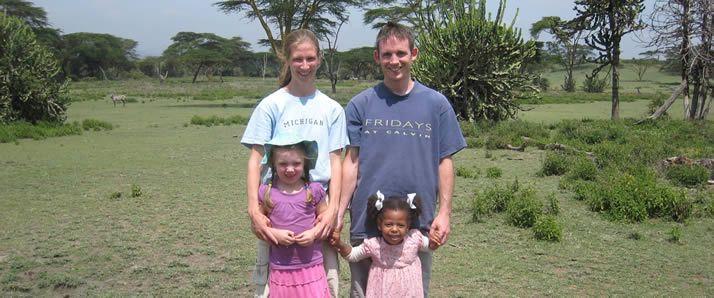From chem lab to a Burundi mission

There’s been no voice from heaven, no writing on the wall. But to Jason Fader ’99 and Heather Reedyk Fader ’99 it has all the signs of a divine call.
“It” is the work they and six friends (two couples and two single adults) will begin in early 2014, when they become the entire clinical faculty at the new—the second of only two—medical school in Burundi.
It’s a call that has come together gradually, organically, one the Faders trace back to their childhoods. Heather accompanied her physician-father on short-term medical mission trips to Honduras. Jason grew up in Kenya and by the fifth grade was making hospital rounds with his doctor-dad. By age 10, both Heather and Jason knew, “That’s what I want to do when I grow up.”
They met at Calvin and became freshmen chemistry lab partners. After graduation they married, and Jason started medical school at Loyola University. Talking to physician couples, Heather decided with some relief that their life-in-mission would be stronger if she were not also a doctor. She began a master’s degree in education.
It’s when the Faders moved to Ann Arbor for Jason’s surgical residency that their call began to take a surprising shape.
Working at St. Joseph Mercy Hospital, Jason met medical student John Cropsey, who had grown up in Togo. He and his wife, Jessica, planned to return to Africa once he was an MD. Both the Cropseys and Faders attended Knox Presbyterian Church, where they met Eric and Rachel McLaughlin, husband-and-wife doctors planning to become medical missionaries after their residencies.
It started as a kind of joke among the three couples: Hey, we should go to the mission field together. The joke turned into serious conversations. Jason remembers a critical one, on a summer evening in 2007:
“We said, ‘What if God has orchestrated it so that all of us would be together in this same town, finishing residency at the same time in different specialties, all of which are complementary, so that we could go out as a group and usher in the kingdom of God together?’”
“It seemed unlikely enough that we could hardly attribute it to anything but God,” Heather added. “So we decided to pursue our calling as a team calling and see if God closed that door.”
At a medical missions conference the group found one—just one—organization that would take all of them together. In the fall of 2009 the three couples arrived at Tenwek Hospital in Kenya, amalgamating their last names into a team name: the McCropders.
For two years they worked and lived together, mentored by long-term missionaries in everything from the practice of medicine in Africa to homeschooling. At Tenwek they met Alyssa Pfister, an American doctor who resonated with their calling. Then Carlan Wendler, another friend from Ann Arbor who was finishing his residency in California, called to say he, too, wanted to join. Their last names, both ending in “er,” nicely fit the McCropder team name.
The group took the Tenwek experience as a trial run for its calling and during that two years felt it confirmed.
“So,” Jason said, “we looked for a longer-term opportunity, a needy place where we could use our gifts to their greatest potential.”
Burundi is that place. Poorest country in the world, there are only eight surgeons for a population the size of Chicago. One of every 103 women dies in childbirth. A new Christian university, Hope Africa University (HAU), has started a medical school, but it has had no permanent clinical faculty to teach its eager students, only short-term volunteers.
The McCropder team, with six doctors in six different specialties, can teach a whole curriculum. After 15 months of language school in French and Kirundi, the eight McCropder adults and seven children will take up residence at Kibuye Hope Hospital, HAU’s teaching hospital. Three hours away in the bush, Kibuye does not yet have sufficient running water, reliable electricity or Internet access.
“It’s definitely daunting,” Jason said. “But Frederick Buechner says, ‘True vocation is where your deep gladness meets the world’s deep need.’ That’s what we’ve found in Burundi.”






